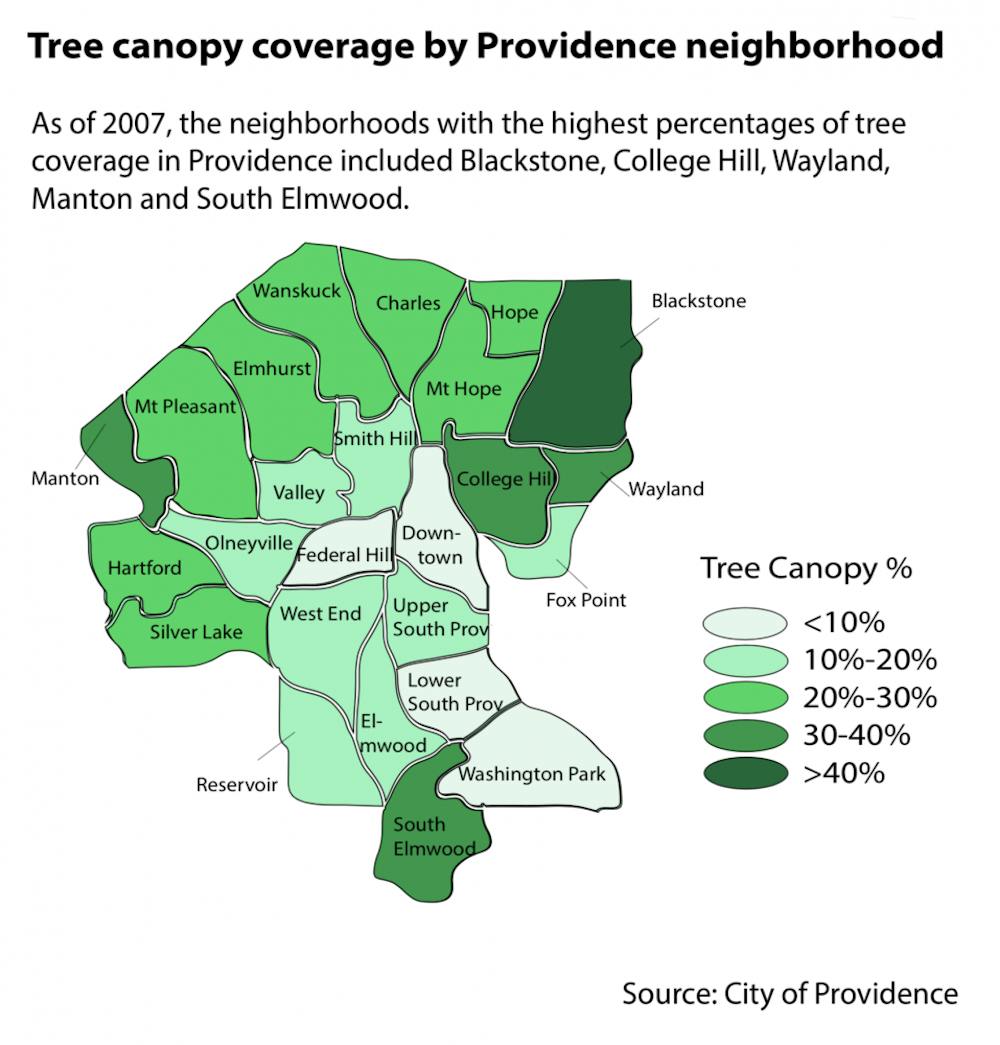As climate change contributes to a warming Providence, symptoms of already present urban inequality in Providence may worsen as a result.
With longer and more severe heat waves and increased flooding already occurring, city officials and researchers say that low-income neighborhoods in the city will bear the worst of these effects.
To combat the growing threats of climate change that low-income neighborhoods will face, the City’s Office of Sustainability is continuing its work on its Climate Justice Plan. While not finalized, the plan is set to be released in the coming months, wrote Leah Bamberger, director of the Office of Sustainability, in an email to The Herald.
Climate Change exacerbates city inequities
Over the last four decades, the number of days in Providence with a heat index over 80 went from roughly 55 days in a year to 75 days, said J. Timmons Roberts, professor of environmental studies and sociology. Low income neighborhoods are most vulnerable to the effects of the heat’s growing intensity, he added.
Specifically, in Olneyville, the South and the West End of Providence, “you see almost no green space or very little green space” which makes people living in the areas more vulnerable to the effects of heat waves, such as heat stress and stroke, he said.
Without trees and green space, the areas become urban heat islands as the sun warms up the pavement and buildings. The pavement does not cool off overnight, which would allow people to recover from the heat’s intensity.
Smog will also be much worse during heat waves, which also presents health hazards to the communities most affected, Roberts said. Currently, low-income communities in Providence experience “a lot of the worst pollution,” while the East Side sees “few to no pollution emitting facilities,” Roberts said. Plans to construct a liquified natural gas plant in South Providence were approved in October, to the dismay of many community members and environmental advocates.
The root of pollution in low-income neighborhoods can also be attributed to their proximity to highways and fossil fuel infrastructure. “The closer you are to the highway the more that impacts you,” Bamberger wrote. South Providence, which is located next to the Port of Providence, also faces increased pollution due to a higher concentration of diesel burning ships and large petrochemical tanks. “The folks that live there not only deal with the smell, but also the other toxins being released into the community, and it’s having an impact on the health of our children and other folks in that area,” said Lucy Rios, a member of the city’s Racial and Environmental Justice Committee. “No one seems to care about that,” she said.
As the increasing heat risks producing more smog, the already high rate of asthma in Rhode Island is expected to grow. The state has the ninth highest prevalence of asthma in the country, according to Julian Rodriguez-Drix ’08, the asthma program manager at the Rhode Island Department of Health.
Additionally, studies show Providence’s low-income neighborhoods have the highest asthma rates in the state, Bamberger wrote. With climate change exacerbating these rates, the state Department of Health is currently working with other agencies to consider policy changes around healthy housing, air quality, transportation and lower emissions.
“Asthma is a huge concern, especially in the area around the port,” Rios said, adding that addressing it is among the REJC’s top priorities.
One of her fellow committee member’s children have been “in and out of the hospital for days sometimes because of their asthma. … They feel like it’s invisible to the state of Rhode Island,” she added.
The fossil fuel infrastructure also exacerbates health risks during heavy rainstorms and increased flooding, which have occurred more frequently and intensely with climate change. Heavy precipitation and flooding along the rivers can dislodge chemicals found in soil and sediment in industrial areas, Drix said. This can impact nearby communities, like Olneyville. “We have a legacy of contamination in an old historic city like Rhode Island with industry, so that’s something that comes up when you’re thinking about what happens after a storm,” Drix said.
Providence races against time to address climate change threats
To confront the dire realities of climate change, Providence’s Office of Sustainability is working to complete its Climate Justice Plan. The Providence City Council originally anticipated reviewing and considering the plan in March, ecoRI reported.
The Climate Justice Plan will lay out a path to meet Mayor Jorge Elorza’s goal of a carbon neutral Providence by 2050 in an equitable way, according to Bamberger. It will set forth concrete carbon reduction targets in the areas of buildings, clean energy and transportation, Bamberger wrote. To protect low-income communities that lack tree canopy coverage and experience smog, the Climate Justice Plan intends to offer solutions and mitigation such as reducing local carbon emissions and co-pollutants from existing fossil fuel infrastructure.
The plan was originally created “through a collaborative planning process with folks who are most impacted by climate change — including low-income communities of color,” Bamberger wrote. The city convened the Racial and Environmental Justice Committee in 2016 to inform the plan and address concerns around environmental inequality within these communities. The group, which is still working today, also aims to create a long-term dialogue with the Office of Sustainability.
From its interviews with community members, the REJC noted concerns over the lack of trees and open space in their neighborhoods, as well as the announced LNG facility and a high number of gas leaks, Rios said.
While the results of the Office of Sustainability’s and the REJC’s work remain to be seen, the city aims to raise awareness over climate change’s effects on existing environmental inequalities. People living in the communities that will likely be the most affected by climate change may not be “connecting those dots,” Rios said. “Their lived experiences are what we’re trying to capture,” she added, which will allow the committee and city to “make solutions that will work for all people.”





